Share As A Gift
Share a paywall-free link to this article.
This feature is only available for subscribers.
Start your subscription for as low as $4.95. Already a subscriber?
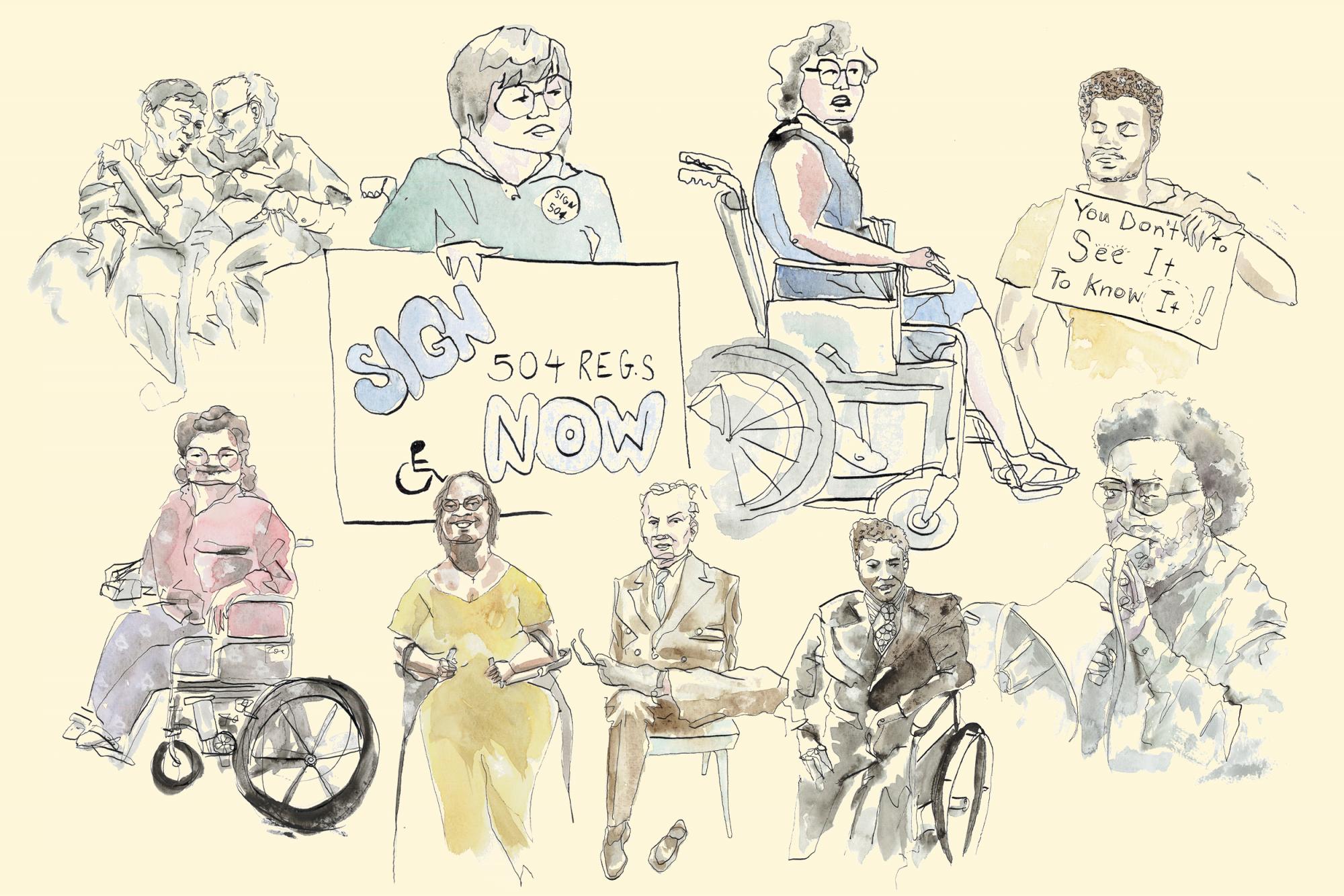
(Top row, from left): Denise and Neil Jacobson, Judy Heumann, Kitty Cone, Dennis Billups. (Bottom row, from left): Mary Lou Breslin, Letiah Fraser, Harold Wilke, Brad Lomax, and Cecil Williams. Illustrations by Indigo Ayling
ON GOOD FRIDAY 1977, Dennis Billups and Judy Heumann, along with six other disabled activists, were on hunger strike. It was their fourth day occupying the San Francisco Department of Health, Education, and Welfare (HEW) alongside more than 100 protesters. The eight activists did not break their fast three days later when many of their Christian counterparts in the sit-in celebrated Easter. Instead, they continued without food, waiting with hope for their own improbable victory despite seemingly
insurmountable odds.
The 26-day occupation of the HEW building was the longest nonviolent occupation of a federal building in U.S. history. In the early 1970s, disabled people were routinely excluded from public transportation, libraries, and other public spaces. Four out of five disabled children were not enrolled in public education; many states had laws excluding students with disabilities from public schools. The landmark Rehabilitation Act of 1973 prohibited discrimination based on disability in programs conducted by federal agencies, in the employment practices of the federal government and its contractors, and in programs that received federal financial aid. Section 504 of the Rehab Act contained the ban on discrimination against disabled people by recipients of federal funds. Yet four years had passed since 1973, and the Carter administration still had not signed regulations to enforce Section 504. Disabled people were losing patience.
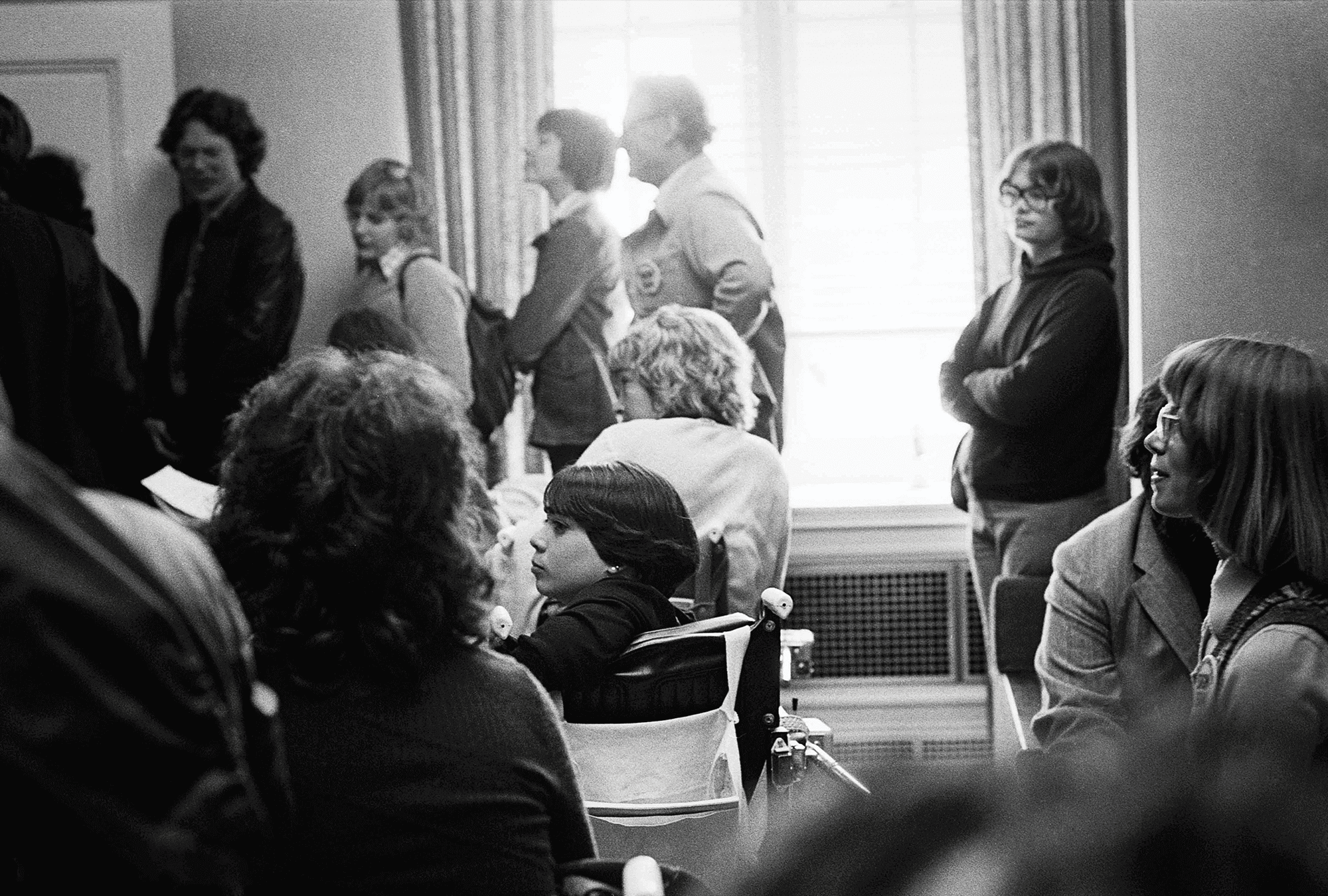
Protesters inside the San Francisco federal building wait for a HEW spokesperson before the 504 sit-in. / Anthony Tusler
When the American Coalition of Citizens with Disabilities heard that federal officials planned to change the drafted regulations to permit “separate but equal” facilities and to remove protections for people in drug and alcohol recovery, the coalition called for sit-ins in federal buildings across the country. Many sit-ins ended quickly, but the San Francisco sit-in continued until HEW Secretary Joseph Califano signed the originally drafted federal regulations into law.
The stakes of such a long sit-in were especially high for disabled people. Disability rights leader and 504 sit-in organizer Heumann wrote that many participants risked “our health and our lives to be without catheters, back-up ventilators, and attendants.” Some protesters lived with the physical consequences of the protest for years.
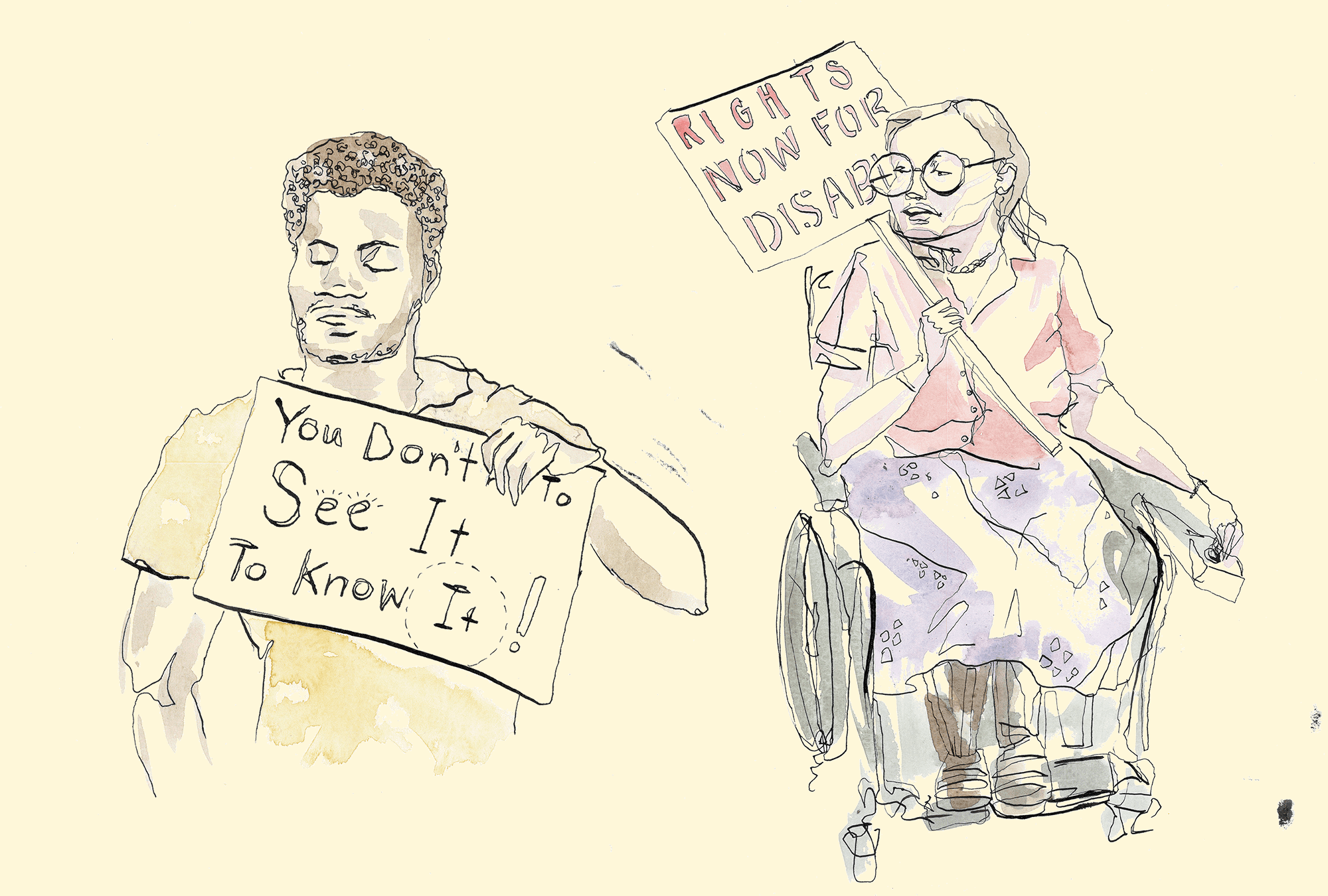
Disabled activist Dennis Billups (left) and Judy Heumann (right), one of the lead organizers of the San Francisco 504 sit-in. Illustrations by Indigo Ayling
REPLICATING HOSTILE TACTICS that ended the Washington, D.C. sit-in, San Francisco officials cut the phone lines and prevented food or attendants from entering the building. At one point, the occupiers bravely remained in the building during a false bomb threat. But the protesters had many powerful supporters on the outside of the building.
As HEW officials restricted communication with those on the outside, the Butterfly Brigade, a gay men’s group who patrolled city streets to prevent violence against gay people, snuck walkie-talkies into the building. Deaf occupiers leaned out the windows to sign to supporters outside.
San Francisco Mayor George Moscone (later assassinated along with Harvey Milk, the first openly gay man elected to public office in California) insisted that HEW officials allow food inside the building, and he continued to vigorously support the protesters throughout the occupation. Organizations across the Bay Area came together to feed the occupiers, with the Black Panther Party providing hot dinners in support of occupying Panthers Brad Lomax and Chuck Jackson. Other groups who provided food included Berkeley’s lesbian-owned Brick Hut Café collective, the Delancey Street Foundation (a residential rehabilitation center for substance abusers), the Chicano group Mission Rebels, and local branches of McDonald’s and Safeway.
Religious groups also sustained the protesters. According to Heumann, pastor Cecil Williams was one of the “staunchest supporters” of the sit-in, and his church, Glide Memorial in the Tenderloin neighborhood, stepped up to provide food. The head of the San Francisco Council of Churches entered the building every Sunday to hold services.
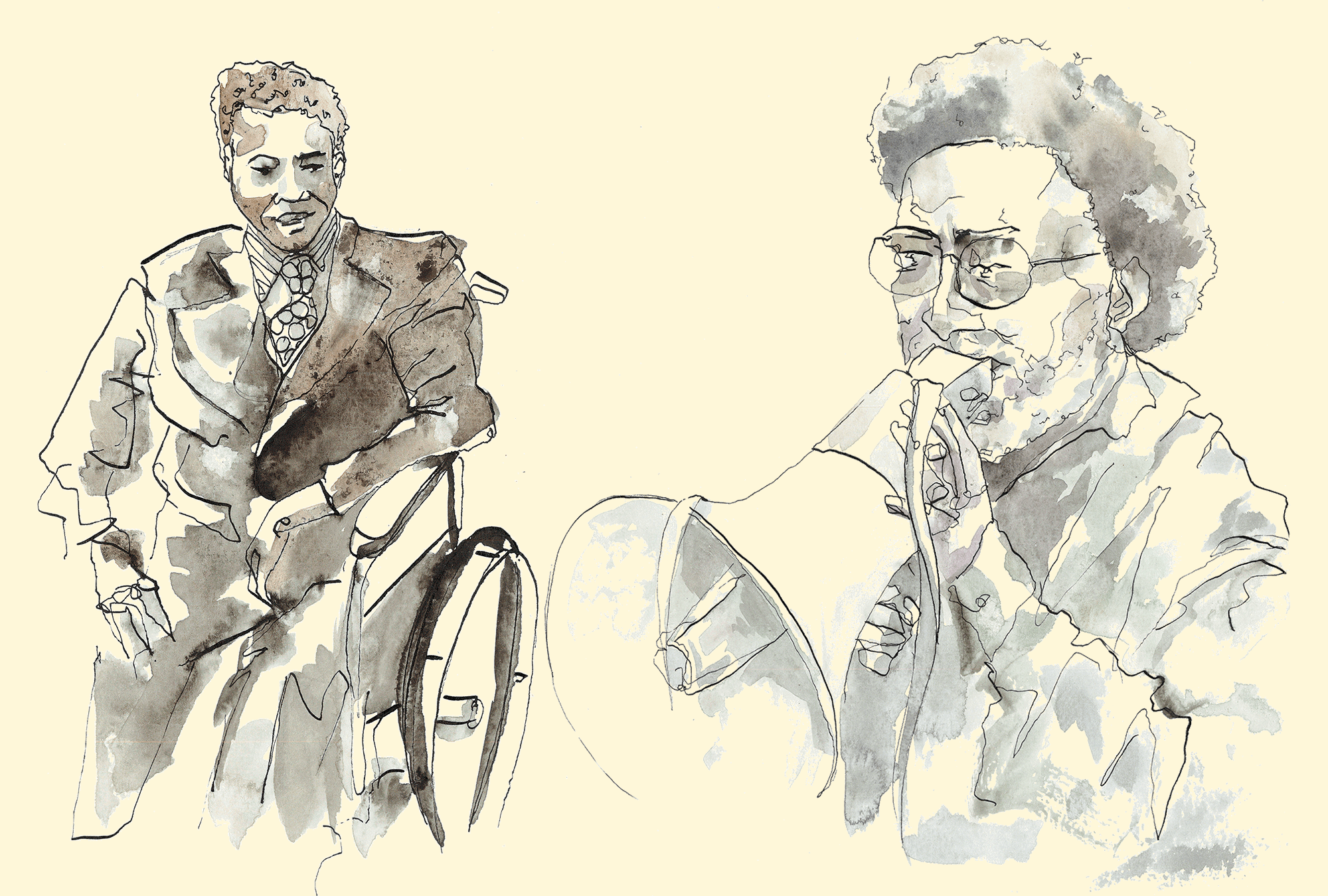
Black Panther Brad Lomax (left) and Glide Memorial Church pastor Cecil Williams. Illustrations by Indigo Ayling
Heumann told Sojourners the entire sit-in was spiritual because “we had faith in each other.” Dennis Billups, a 504 protester who led the group in meditation, songs, and chants, described the Christian and Jewish religious gatherings as “passionate.” Jewish protesters entered the building during Passover, and, as they celebrated the Hebrews’ liberation from Egyptian oppression in the elevator of the HEW building, they prayed for their own liberation from ableist exclusion. Billups recalled the moments of prayer, meditation, and conversation as crucial for strengthening cross-disability solidarity because, as he told Sojourners, they “linked hand and hand, heart to heart, mind to mind, and spirit to spirit together.”
When the San Francisco occupiers decided to send a group of representatives to Washington to increase pressure on Secretary Califano to sign the regulations, they marshalled community support again. Willy Dicks, a member of the International Association of Machinists and Aerospace Workers (IAM), heard Williams preach at Glide Memorial about the sit-in, and he convinced IAM to provide travel funds, logistical support, and food. The Black Panther Party paid the travel costs of its members. After touching down in Washington, the group made their way to Califano’s house, where they sang hymns and held a candlelight vigil throughout the night. Luther Place Memorial Church allowed IAM to do accessibility remodeling and provided the protesters with a place to sleep for the rest of their trip. Luther Place pastor John Steinbruck amplified the pressure on Califano and President Carter by inviting them to a prayer breakfast with the protesters. He received no response.
AFTER THE PROTESTERS had been in the capital for 10 days, Califano yielded to their demands and signed the 504 regulations—undiluted from the original drafts. The 504 regulations “opened up a whole new world of access,” Denise Jacobson, an activist with cerebral palsy who lobbied for the passage of the Rehabilitation Act of 1973, told Sojourners. Her husband, Neil Jacobson, a disability advocate who also has cerebral palsy, added, “Whenever I see a ramp to a building or a wide bathroom stall, a wheelchair user getting onto a bus, or parents with disabilities playing with their kids at an accessible playground, I think about Section 504” and the other disability rights legislation that Section 504 inspired.
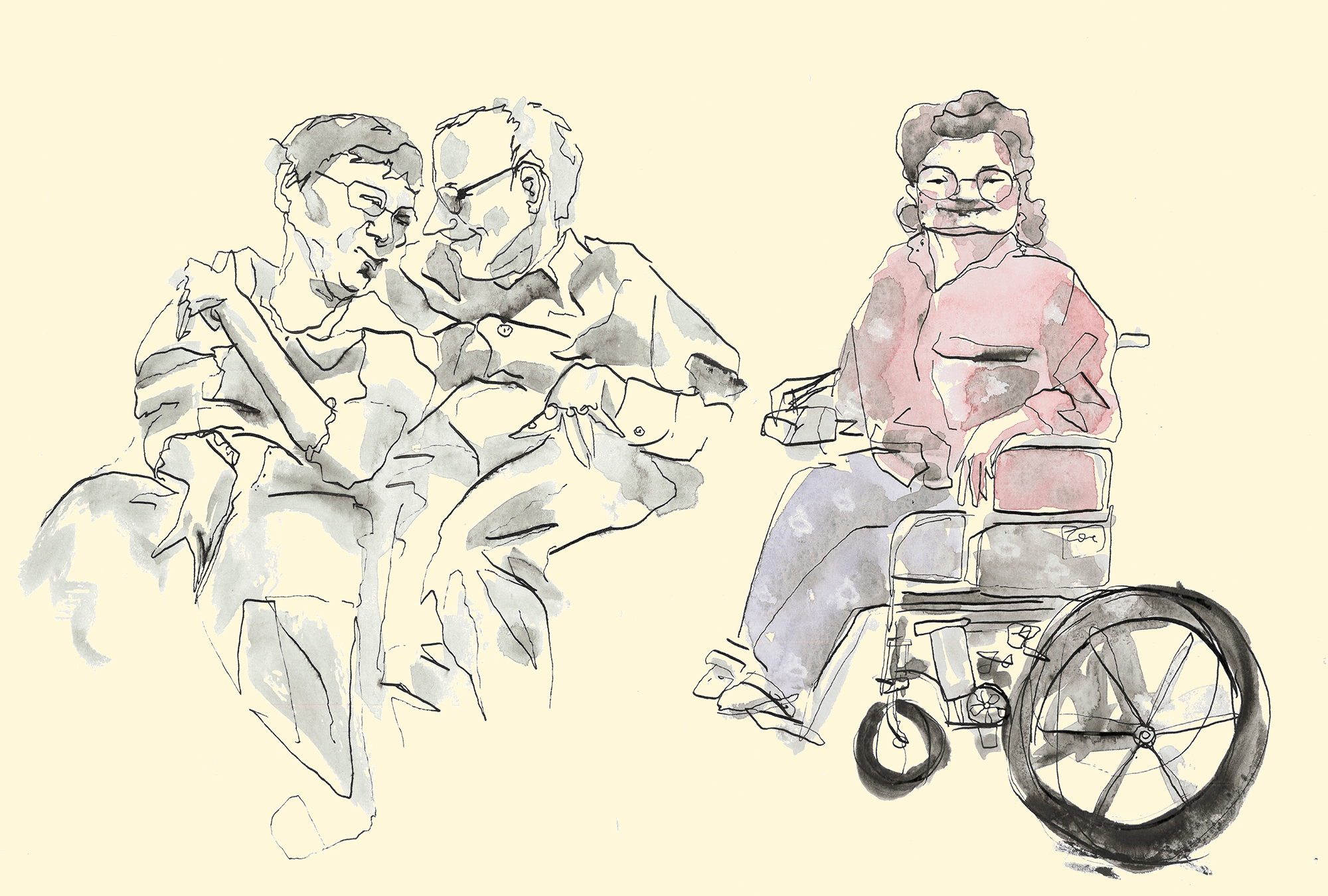
Disability advocates Denise and Neil Jacobson (left) and Mary Lou Breslin, a lead organizer of the San Francisco 504 sit-in. Illustrations by Indigo Ayling
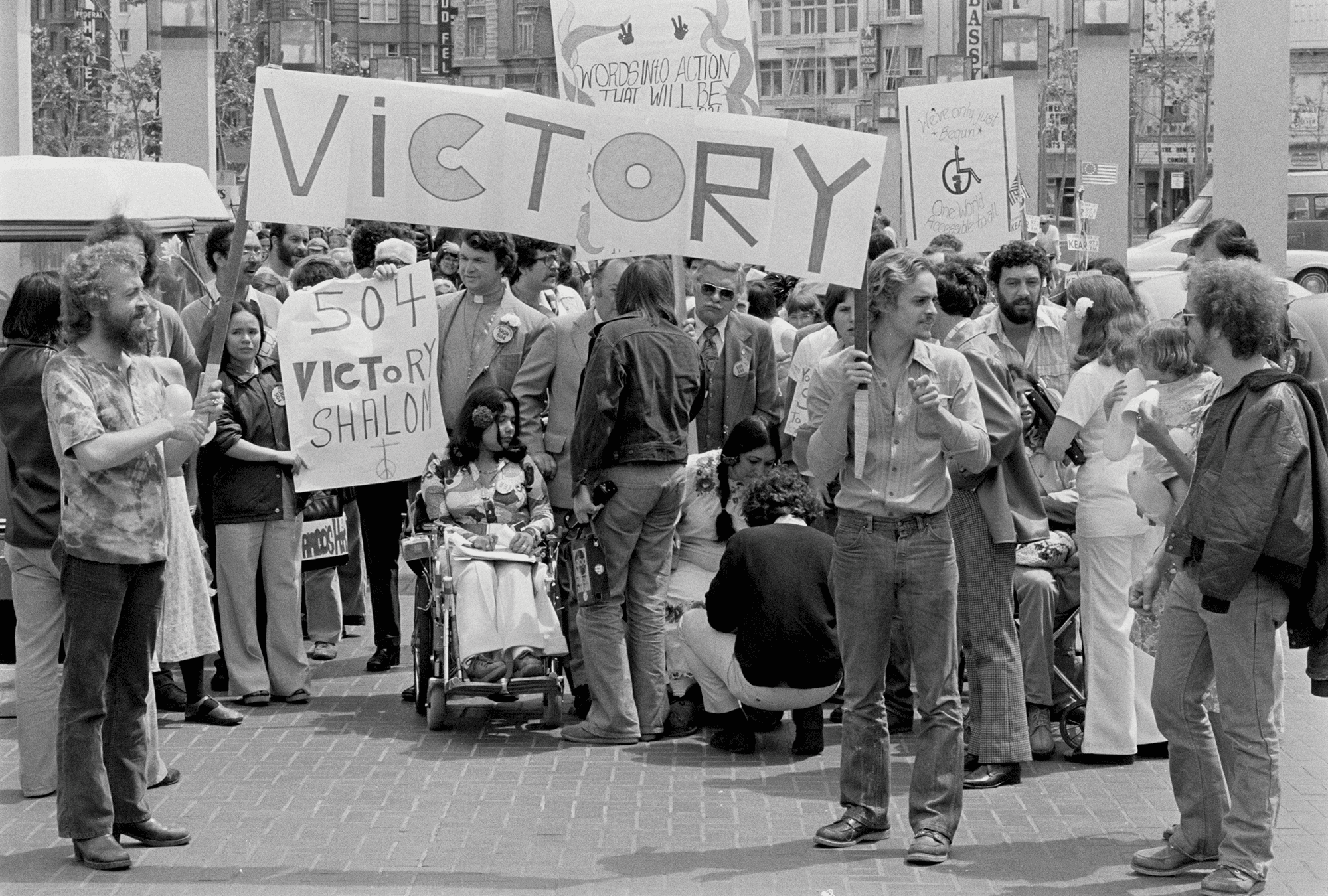
Occupiers and supporters gather in San Francisco's Civic Center Plaza to celebrate the signing of the Section 504 regulations in 1977. / San Francisco Examiner via Bancroft Library.
The refusal in 1977 of protesters with mobility and sensory disabilities to allow the exclusion of people with addictions from Section 504’s civil rights protections set a precedent for the fight for the ADA. Disabled people fought for each other’s rights together, even though different groups had different accessibility needs. As disabled activists pushed for a law to extend Section 504’s protections to the private sector, they maintained those cross-disability coalitions. In March 1990, wheelchair-using activists captured national attention during the “Capitol Crawl” when they set aside their wheelchairs and other mobility aids and crawled up the Capitol steps to demonstrate how inaccessible architecture impacts disabled people. Congress swiftly passed the Americans with Disabilities Act that extended disability rights protections throughout the private sector. More of society started learning how to take responsibility for the social inclusion of disabled Americans through accommodations.
I work at Sojourners today because of disability rights legislation. When I became disabled as a teenager, I experienced some of the same stigma and ableism that the 504 protesters fought against, but the legal protection that they fought for kept me in school. Like many other disabled people in the ADA generation, I finished high school and college and then found a job because of the civil rights laws that disabled protesters fought for.
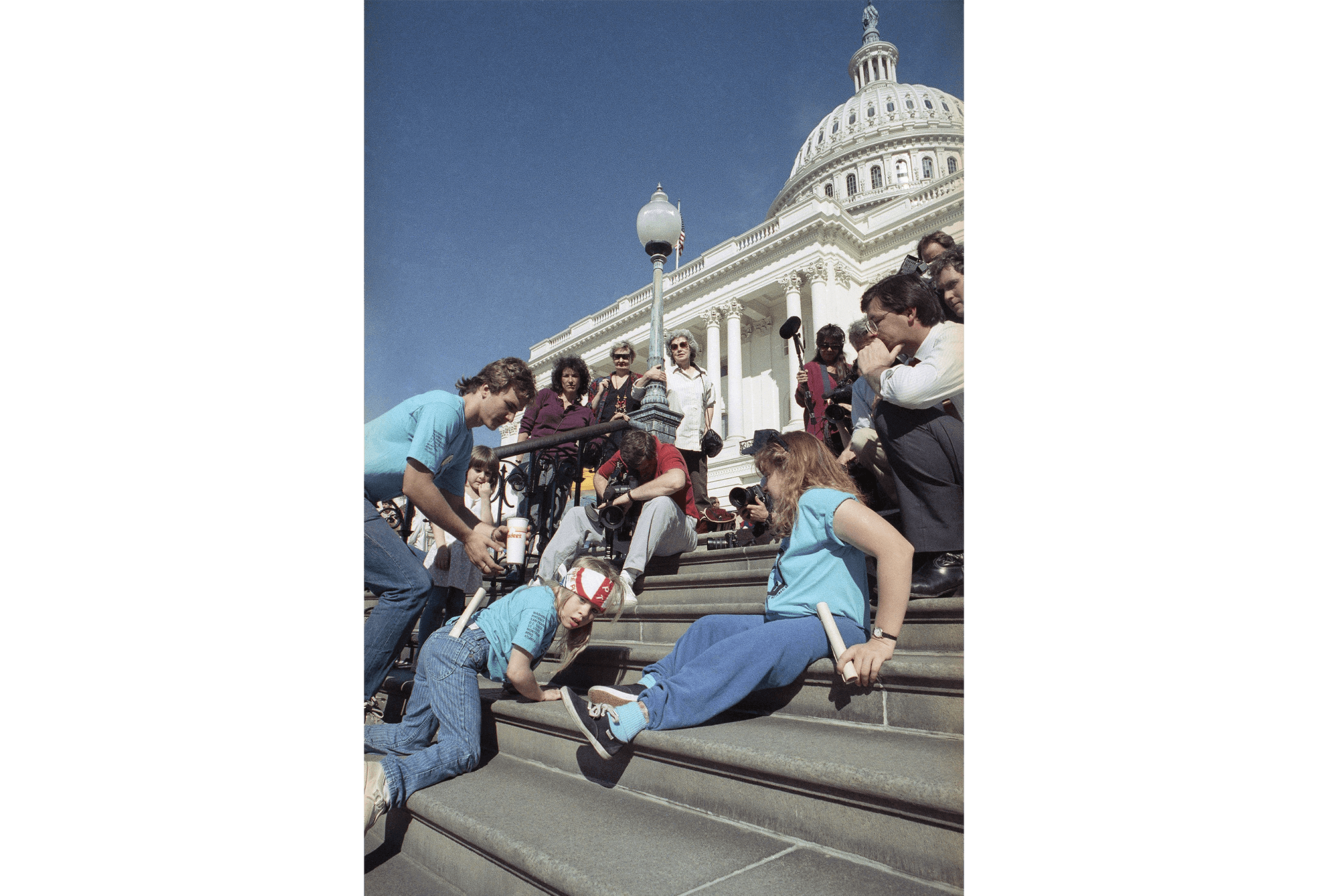
A group of wheelchair-using activists led by 8-year-old Jennifer Keelan, left, crawl up the steps of the U.S. Capitol in 1990 / AP Photo / Jeff Markowtiz
THERE WERE A few church leaders such as Harold Wilke, a disabled United Church of Christ minister, who recognized the transformative potential of the ADA and fought for its passage. But the vast majority of the institutional church used its power to protect itself from the ADA. For example, the National Council of Churches, the National Association of Evangelicals, and other religious organizations lobbied aggressively for religious exemptions to the ADA. While the National Council of Churches supported the passage of the ADA overall, it was a lead signatory in demanding religious exemptions. While the National Association of Evangelicals adopted a resolution in 1989 entitled “Ministry to Persons with Disabilities,” it did not support the ADA publicly and lobbied fiercely that, without a religious exemption, the state risked “burdening the church with unnecessary costs” and suppressing “in religious communities the exercise of traditional behavioral disciplines with respect to alcohol, drugs, gambling, or sexual immorality.” Ultimately, this lobbying was successful. Religious groups today are exempt from the ADA.
Some churches have used the ADA exemption to blatantly discriminate against disabled people. Churches have fired employees because of breast cancer, narcolepsy, depression, and bipolar disorder—and used the religious exemption to do so. Many churches continue to lack ramps and pew cutouts for wheelchairs users. Disabled people sit through ableist preaching and receive unsolicited prayers for their “healing.” Church of the Nazarene pastor Letiah Fraser, who has cerebral palsy, put it bluntly when she told Sojourners, “The church is lagging behind mainstream society.”
Religious communities should be places “where people can bring their whole selves,” said Heumann, who is Jewish. Religious institutions have a duty to commit to accessibility, regardless of their current legal obligations, “because they should be examples in our communities of what is just and right.”
To create a community that is just and right, churches must not only include disabled people, but also seek their leadership. Erin Raffety, a Presbyterian pastor and anthropologist, argues that many churches lack vitality because they view people with disabilities as objects of charitable programs (run by nondisabled people) instead of as valuable leaders. Fraser believes new congregations and church plants, where her pastoral leadership and experience as a Black woman with a disability has been intentionally sought out, have been the only places where she can actively shape “the culture around disability theology.” Traditional churches have been too resistant to change.
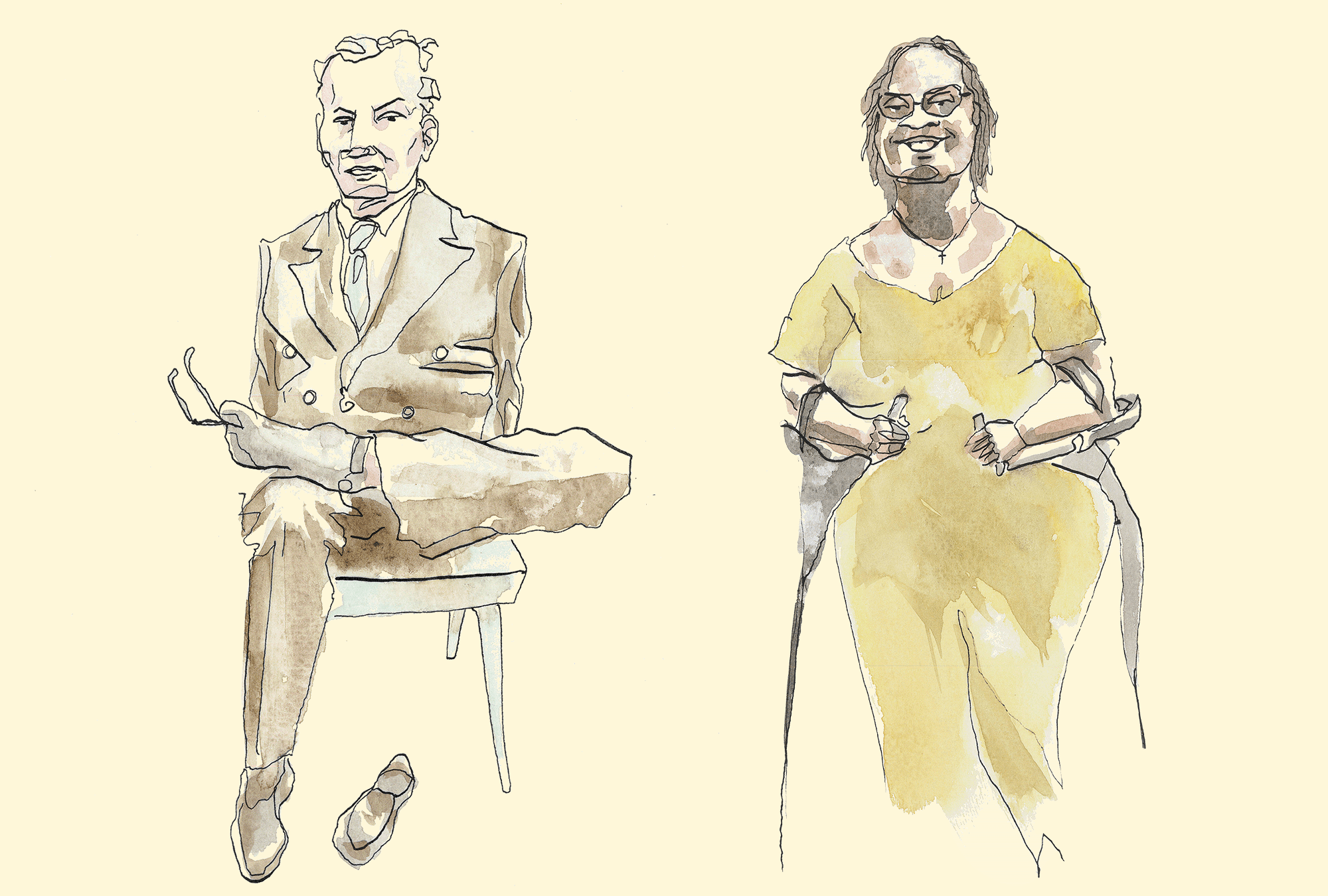
Harold Wilke (left), a United Church of Christ minister, and Letiah Fraser, a Church of the Nazarene pastor. Illustrations by Indigo Ayling
Nancy L. Eiesland, theologian and author of The Disabled God, saw disability theology as key to dismantling “a double-minded stance that holds up the disabled as objects of ministry and adulation for overcoming the very barriers the church has helped to construct.” According to Eiesland, disability theology prods the church to move beyond accommodation to develop an inclusive liberating theology centered around the systemic and social needs of its members of every disability status and reflecting Christ who rises with his wounds intact. “Disability not only does not contradict the human-divine integrity, it becomes a new model of wholeness and a symbol for solidarity,” Eiesland wrote. In understanding disability, we can turn to scripture. Denise Jacobson, who is Jewish, pointed out that “there are many people in the Bible that have a disability,” including Moses, Isaac, and Jacob. Understanding these stories can dissolve myths about the normal body and mind. As Fraser noted, “God has created all bodies in God’s image.”
“DISABLED PEOPLE COME from all communities,” Heumann emphasized. Disability justice is enmeshed with issues facing all marginalized communities. It builds on the disability rights movement’s work by engaging in cross-disability and cross-movement coalitions, while also building beyond the legal framework of rights, a framework that does not adequately address the oppression of multiply marginalized disabled people. “The white supremacist structure wants us all to segregate,” Fraser told Sojourners, underscoring the importance of working in solidarity for disability justice.
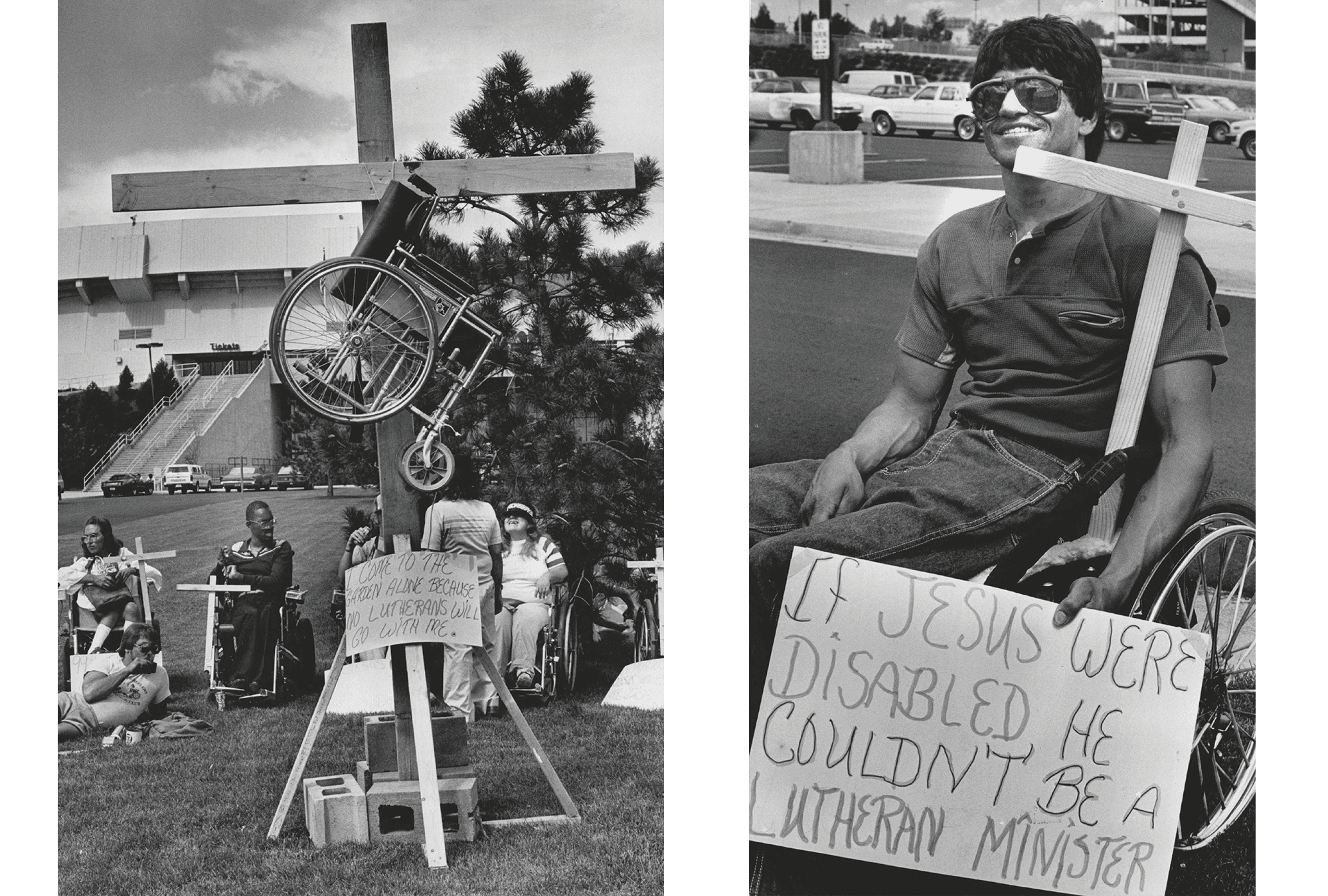
After the Lutheran Church barred disabled people from ordination, Lonnie Smith (right) and other activists hung a wheelchair from a cross and protested outside the 1985 Lutheran Youth Gathering in Denver. / The Denver Post via Getty Images
Disabled people are disproportionately impacted by almost every type of violence and injustice in the U.S., especially compared to their nondisabled peers. Working-age disabled people are more than twice as likely to live in poverty. Disabled people are three times more likely to experience physical abuse or sexual assault, and people with intellectual disabilities are seven times more likely to be sexually assaulted. Deaf and disabled Black people are especially at risk for police violence, where “compliance culture” justifies the use of force against anyone who does not respond immediately to police commands as a nondisabled person would. Studies estimate that between one-third and one-half of people killed by the police are disabled. By recognizing the intersectional nature of the oppression that multiply marginalized disabled people face, we can seek out leadership in communities of the most impacted. They are the experts through their lived experience.
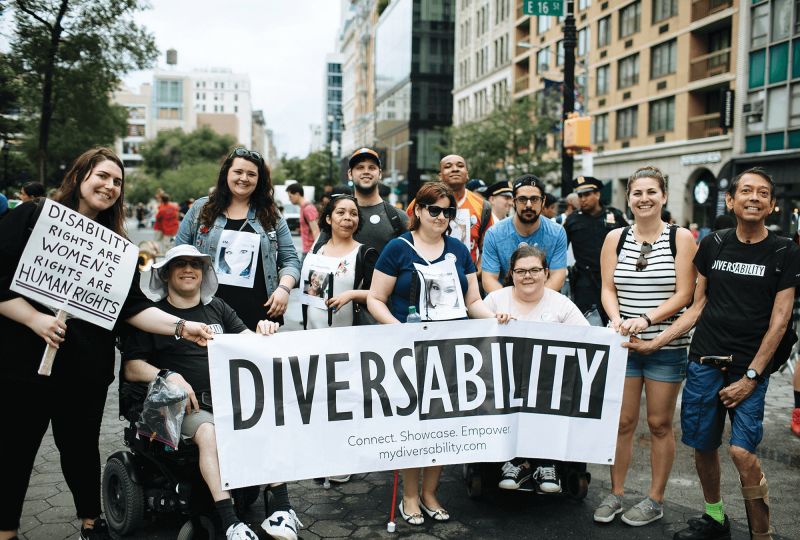
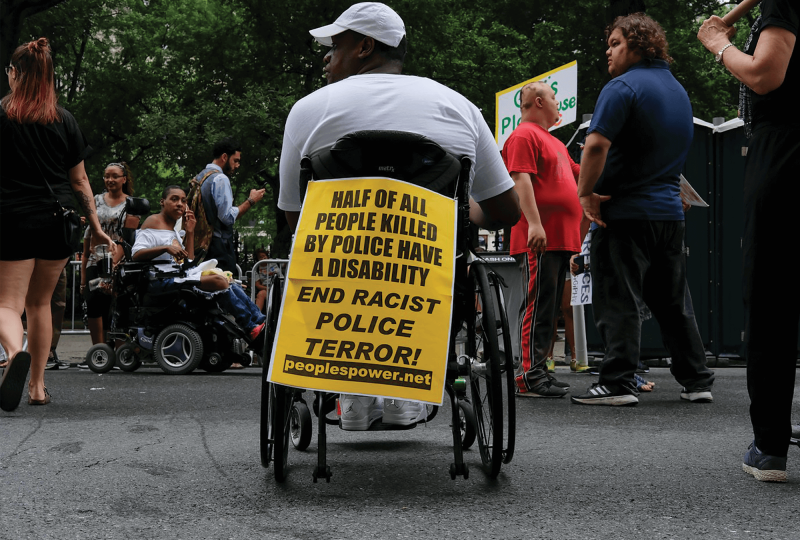
Disabled activists and allies take part in the 2018 Disability Pride Parade in New York City / Jennifer Brister for Diversability LLC (left) and Alamy Stock Photo/Nolan Ryan Trowe
During the San Francisco sit-in, the Black Panthers, gay and lesbian organizations, and a wide coalition of others stepped forward because they understood that our liberation is intertwined. Glide Memorial’s Cecil Williams and Luther Place’s John Steinbruck understood this too. Together with their churches, these pastors demonstrated Christian solidarity, which the broader church also should have shown.
April 2022 marks the 45th anniversary of the San Francisco 504 sit-in. It’s time for the entire church to commit to intersectional disability justice, not only to repent for the harm the church’s ableism has done but because disability justice is at the heart of the gospel.
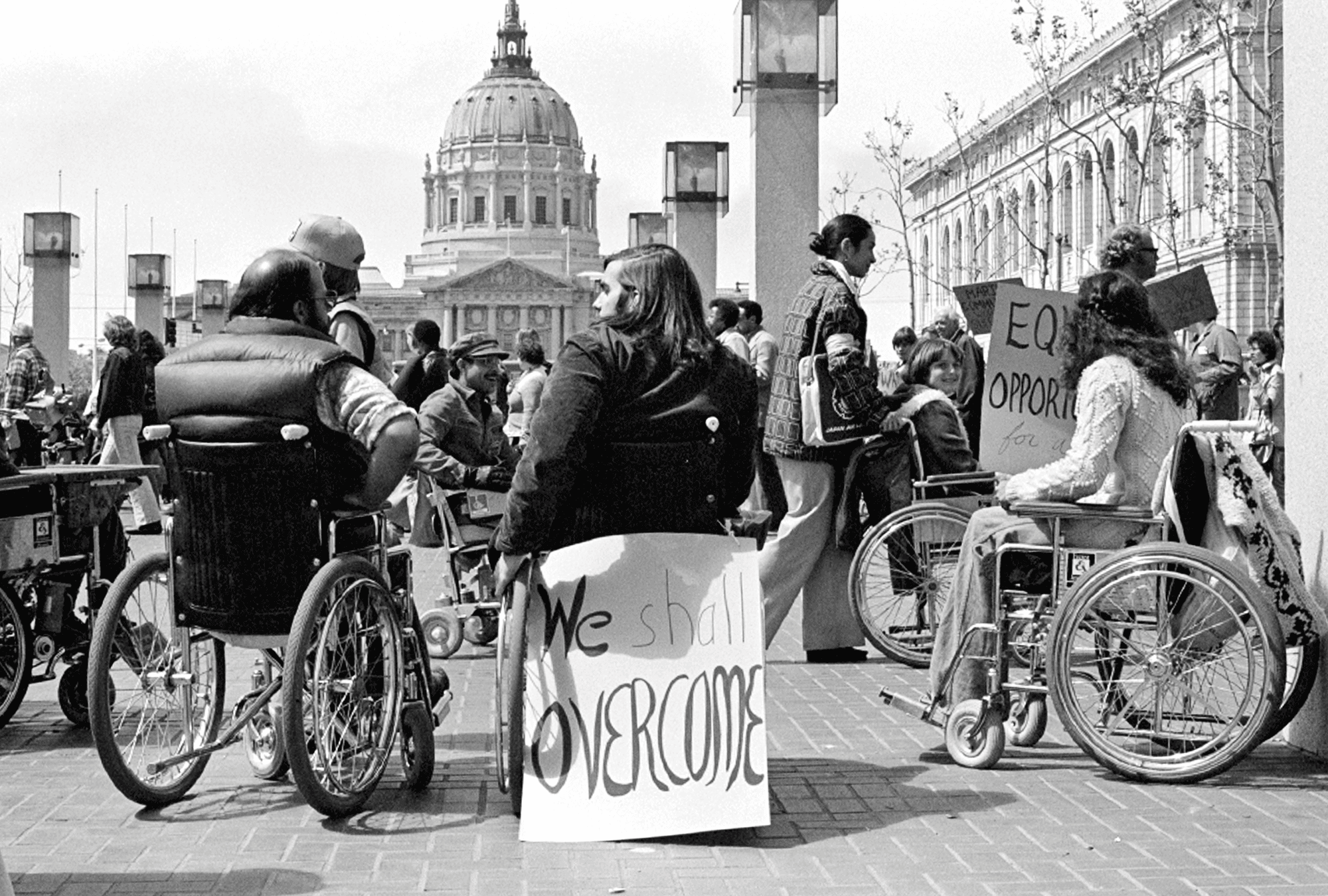
Protesters gather outside the federal building in San Francisco in April 1977 before beginning a 26-day sit-in. / Anthony Tusler

Got something to say about what you're reading? We value your feedback!